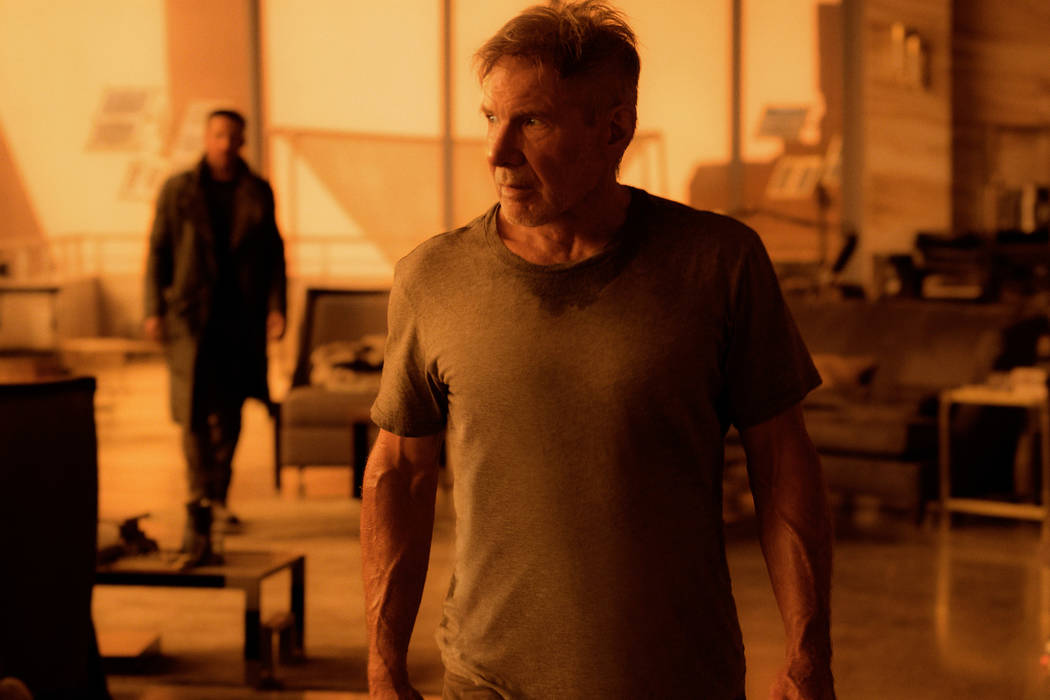Secrets of wondrous ‘Blade Runner 2049’ are worth keeping

The first rule of “Blade Runner 2049”? You don’t talk about “Blade Runner 2049.”
Sure, variations of that have become a cliche ever since “Fight Club” hit movie screens in 1999. But there’s honestly so very little I can say about this terrific 35-years-later sequel to the Ridley Scott classic that wouldn’t ruin some part of the viewing experience.
The list of “please don’t reveal these spoilers” that was read aloud after the press-only screening — something that almost never happens to begin with — was longer than any I’ve ever received for a movie or TV series.
It’s the only screening for which I’ve had to wear a nightclub-style wristband just to gain admittance.
“Blade Runner 2049” has been so closely guarded, and was seen so late by studio executives, I wasn’t even able to get a proper response to whether Las Vegas plays a role in it, despite Ryan Gosling saying it did all the way back in March during CinemaCon at Caesars Palace.
I won’t say how, why or when. But the Strip most certainly makes an appearance. And it looks spectacular.
Las Vegas certainly has fared better over the decades than San Diego, which is now a municipal waste district for Los Angeles. (And you thought San Diegans were upset when the city took their beloved Chargers.)
So, let’s see. What can I talk about?
K (Ryan Gosling), like Rick Deckard (Harrison Ford) before him, is an LAPD officer dedicated to retiring — aka killing — synthetic humans known as replicants. K’s boss (Robin Wright) sends him to dispatch one of the few remaining Nexus 8 models who’ve been in hiding since they were outlawed two decades prior. But what should have been a routine assignment becomes anything but.
First, that replicant, Sapper Morton, is played by the hulking Dave Bautista (“Guardians of the Galaxy”), and he doesn’t want to go quietly.
Second, K discovers a box, buried beneath a dead tree on Morton’s protein farm, that contains a secret for which wealthy industrialist Niander Wallace (Jared Leto) and his assistant, Luv (Sylvia Hoeks), are willing to kill people. Many, many people.
Wallace bought the Tyrell Corporation, which developed the replicants in “Blade Runner,” out of bankruptcy, and he’s improved upon the design. He’s made the perfect disposable workforce — a new model slides out of her packaging, wet and a little slimy, like a microwaved burrito — to help him colonize new planets. But Wallace needs more Nexus 9 models than he could possibly manufacture. He demands millions of them. Trillions even. And he’s convinced the secret to achieving that is inside that box.
K is curious enough about what’s inside that box that he eventually tracks down Deckard, who hasn’t been seen since hitting the road in 2019 at the end of “Blade Runner.” Deckard’s introduction isn’t as goose-bumpy as the first time you saw Han Solo in “Star Wars: The Force Awakens,” but it’s still a welcome blast from the past.
Director Denis Villeneuve (“Arrival”) and screenwriters Hampton Fancher (“Blade Runner”) and Michael Green, who updated another iconic Ridley Scott movie with “Alien: Covenant,” have crafted a world that stays true to the one created in the original. In this 2049, Pan Am still exists. Even the giant, glimmering Atari sign is back. Thankfully, though, the pleasure model replicants no longer look like the frontwoman for a German New Wave rock band, a la Daryl Hannah’s Pris.
Visually, the sequel is every bit as stunning as “Blade Runner” was for its time. The Asian-fusion version of the future still exists, but instead of mere billboards, hundred-foot holograms of nude women beckon passers-by. Whatever you do, if you have any desire to see “Blade Runner 2049,” don’t wait to watch it on your phone. Get to a theater. The best one you can find.
The filmmakers also take the original’s theme of what it means to be alive to new levels, when they aren’t indulging artistic little detours or letting Jared Leto be all Jared Leto-y.
The pacing of “Blade Runner 2049” is methodical and deliberate. You can see where certain parts of the plot are going long before the characters get there. But the effect is much like how an actual member of the LAPD would proceed on an investigation, as K confirms piece by gorgeously designed piece.
A wondrous work of filmmaking, “Blade Runner 2049” is something you can get lost inside for darn near three hours. Much like Villeneuve’s Oscar-nominated work on “Arrival,” it’s visceral, often spellbinding, even brilliant at times.
Curiously, though, just like “Arrival,” I have no desire to see “Blade Runner 2049” again.
Some experiences simply can’t be replicanted.
Err, replicated.
Contact Christopher Lawrence at clawrence@reviewjournal.com or 702-380-4567. Follow @life_onthecouch on Twitter.